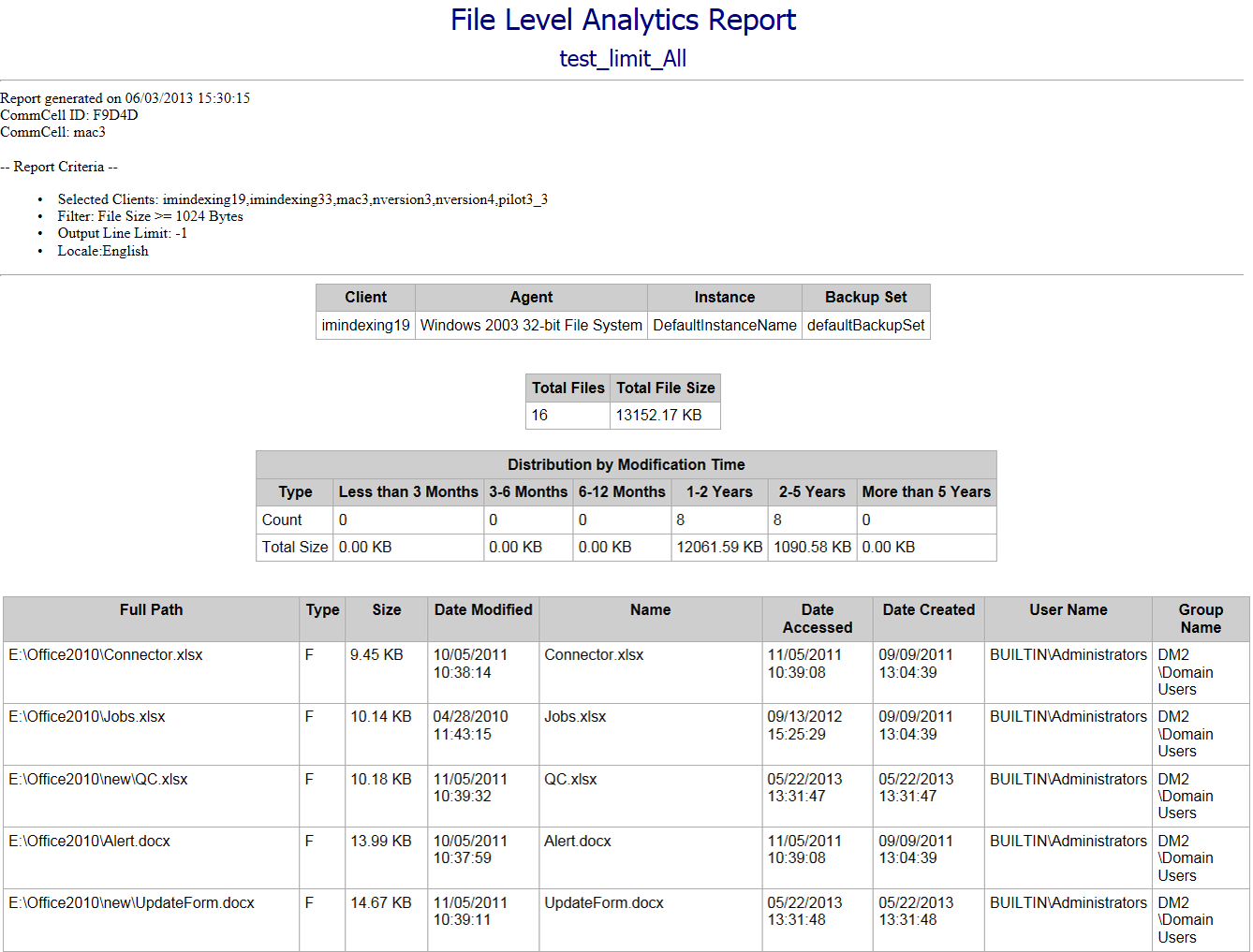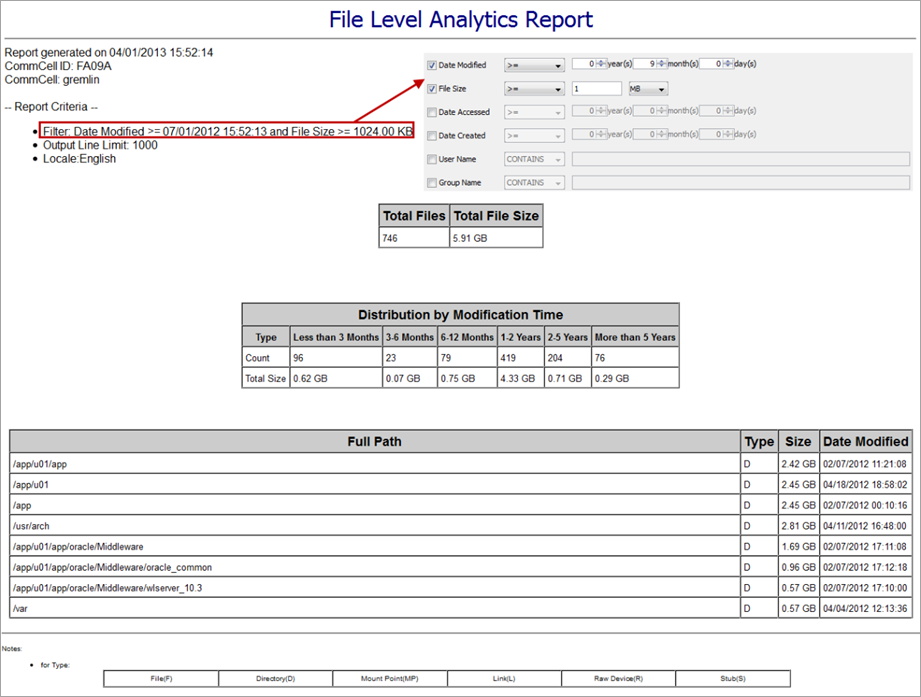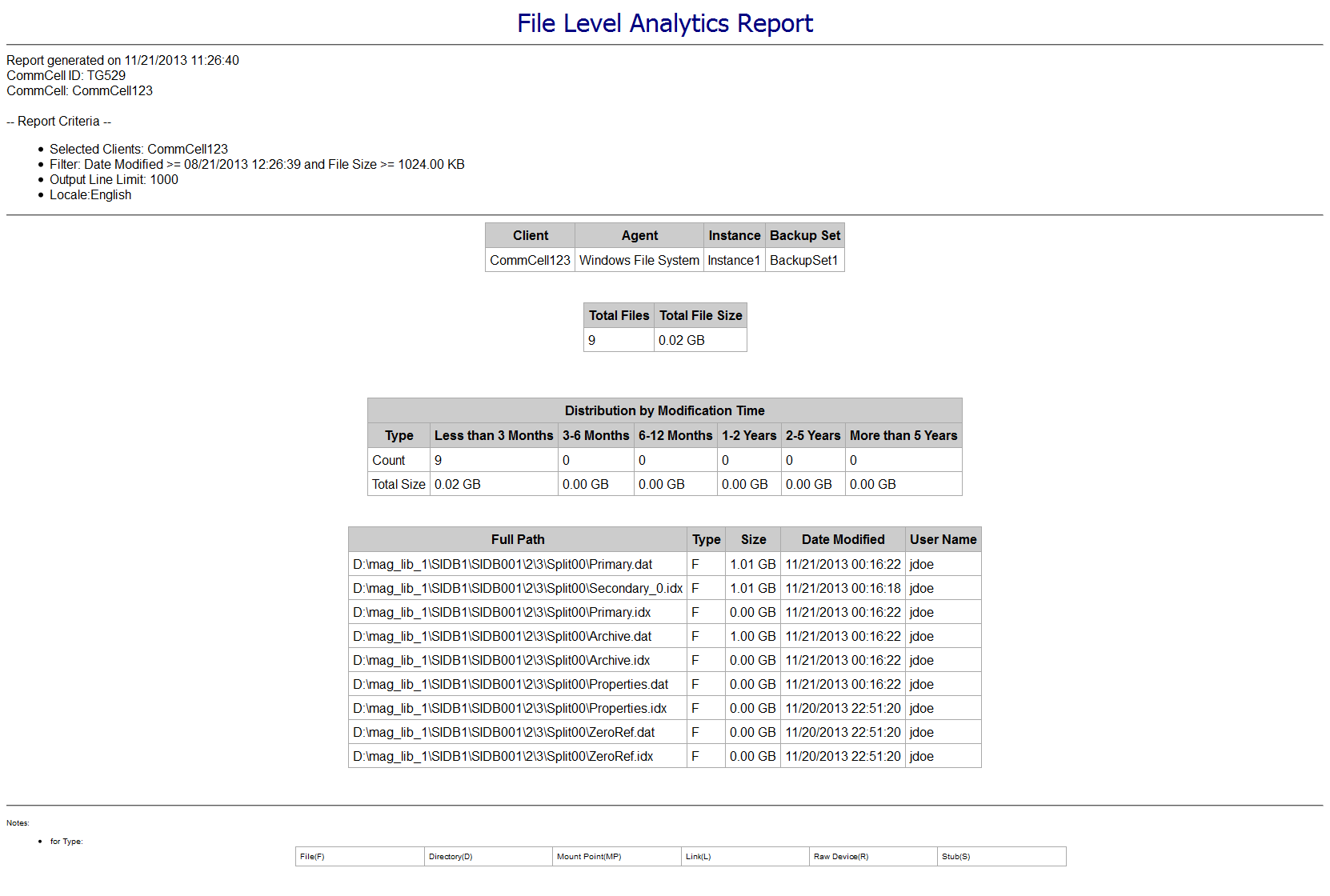File Level Analytics Report displays a list of all files on either the selected clients, agents, backup sets, or subclients and the selected MediaAgent, or the specified backup job at the current time. Information for the selected clients, agents, backup sets, or subclients includes files that were included in the latest backup cycle. Information for the specified job ID includes all files that were backed up during the job.
This option enables collection of information about files, volumes, and directories within the subclient being backed up.
When to Use This Report
You can use the File Level Analytics Report to review all files on a client. This report is useful if you need to know:
-
All objects that were backed up.
-
Files that were modified at a certain time and have a specific size. You can predict the Archive Size by using the Modification Time and File Size filters.
The results of this report can help in determining the values that must be specified while configuring the Archiving Rules using OnePass for Windows File System.
-
All the files that are backed up by a specific job or the latest backup cycle of a subclient.
-
List of files based on their modified times.
-
List of files based on their access times.
What this Report Contains
This report presents the data in the following sections:
|
Sections |
Description |
|
Summary |
This table provides information about files on the any of the following CommCell entities that match the filter criteria. For more information about filter criteria, see Filters.
|
|
Details |
This table provides information about each file on the Client. The information that appears in this table depends on the filter criteria that you configure and the columns that you select on the Output tab. Information displayed in the table can include:
|
|
Distribution by Modification Time |
This table provides information about all files on the selected client. Information is grouped into age categories based on the file's last modified time.
|
How to Generate the Report
You can generate the default version of any CommCell Report on demand in the CommCell Console.
Before You Begin
-
In order to generate this report, the MediaAgents must be installed with the same software version as the CommServe.
-
The data used to generate this report must be indexed. Data that has not been indexed will not be included in the report. For more information, see Indexing - Overview.
-
Your CommCell user account must be assigned to a role that has the Report Management permission.
-
To view report data for an entity, your CommCell user account must have an association with that entity.
For more information on users, permissions, and associations, see User Administration and Security - Overview.
Procedure
-
In the CommCell Console, select the Reports tab, click Other Reports > File Level Analytics.
-
In the Report Selection dialog box, click Run.
The report appears in your default Web browser.
Note
You must select Allow Blocked Content in your browser window to see the count of files.
Scheduling the Report
-
On the CommCell Console menu bar, select the Reports tab, and then click the button for the report that you want to schedule.
-
In the Report Selection dialog box, click Schedule.
-
In the Schedule Name box, enter a name for the schedule.
-
Select the interval at which you want the report to run: One Time, Daily, Weekly, Monthly, or Yearly.
-
Specify the exact times and days that you want the report to run.
-
Click OK.
Customizations that You Can Perform with This Report
You can further customize the report by using the tabs that are available in the Report Selection dialog box. The following table describes the available report options for this report.
|
Options |
Description |
|
General |
On this tab, you can select the backup set, subclient, and MediaAgent for which information is included in the report, or enter a job ID. MediaAgents and Client computers must be at the same version as the CommServe in order to generate this report. You can select one of the following options for report generation:
|
|
Filters |
On this tab, you can configure filters that determine the information that appears in the report. Default options on this tab include the following:
|
|
Output |
You can set the report output to appear in one of several formats and save it to a variety of locations. To make Access Time and Creation Time appear in the report, you must set the Date Accessed and Date Created columns to appear in the report on the Output tab. Set any of the following options:
|
Sample Reports
Multiple Clients with Large Files
View the space consumed by large files on multiple clients:
-
On the General tab, select multiple clients.
-
On the Filters tab, select File Size and then enter >= 1 MB.
-
On the Output tab, under Output Fields, verify that Size appears in the Selected list.

Files Eligible for Archiving
Identify files that are eligible for archiving:
-
On the Filters tab, select Date Modified, and then enter > = 9 months.
-
On the Filters tab, select File Size , and then enter > = 1 MB.
-
On the Output tab, under Output Fields, verify that Size and Date Modified appear in the Selected list.
The results of this report can help in determining the values that must be specified while configuring the Archiving Rules.

Users with the Largest Backups
Identify users with the largest backup jobs:
-
On the Filters tab, select File Size, and then enter >= 1 MB.
-
On the Output tab, under Output Fields, verify that Size appears in the Selected list.
-
On the Output tab, under Output Fields, add User Name to the Selected list.
